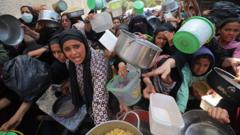
Growing Dismay Among Western Diplomats as Gazans Killed Near Aid Hubs
Tragedy Strikes Amidst Worsening Humanitarian Crisis
The international community is grappling with a deeply concerning situation unfolding in Gaza, as reports emerge of civilians being killed near aid distribution centers. These tragic incidents have sparked outrage and condemnation, with Western diplomats expressing growing dismay over the deteriorating humanitarian conditions and the apparent failure to adequately protect vulnerable populations.
Eyewitness Accounts and Conflicting Narratives
Initial reports suggest that desperate Gazans, already suffering from severe food shortages, were attempting to access much-needed aid when the violence erupted. Eyewitness accounts paint a chaotic scene of panic and desperation, with people clamoring for assistance amidst increasingly volatile circumstances. However, conflicting narratives surrounding the exact sequence of events have emerged, further complicating efforts to ascertain the truth and assign responsibility.
Western Diplomatic Response: Concern and Calls for Investigation
Western diplomats have reacted to the news with a mixture of shock and anger. Many have voiced their deep concern over the escalating humanitarian crisis in Gaza and the increasing vulnerability of its civilian population. Several diplomatic missions have issued statements calling for an immediate and impartial investigation into the killings, emphasizing the need for transparency and accountability.
- Calls for an independent inquiry into the circumstances surrounding the deaths.
- Demands for greater protection of civilians seeking humanitarian assistance.
- Expressions of concern over the worsening food security situation in Gaza.
The Humanitarian Situation in Gaza: A Dire Assessment
The situation in Gaza has been steadily deteriorating for months, exacerbated by ongoing conflict and restrictions on the movement of goods and people. International aid organizations have repeatedly warned of the looming threat of famine and the urgent need for increased humanitarian access. The recent killings near aid hubs underscore the desperation and vulnerability of the Gazan population.
Key challenges contributing to the crisis include:
- Severe restrictions on the entry of essential supplies, including food, medicine, and fuel.
- Widespread unemployment and poverty, leaving many Gazans unable to afford basic necessities.
- Damage to critical infrastructure, including hospitals and water treatment facilities.
- Overcrowding and poor sanitation in refugee camps, increasing the risk of disease outbreaks.
Potential Implications for Peace Efforts
The recent violence and the ensuing diplomatic fallout could have significant implications for ongoing peace efforts in the region. The incidents have further eroded trust and confidence between the parties involved and could complicate attempts to negotiate a lasting resolution to the conflict. Some analysts fear that the escalating humanitarian crisis could also fuel further instability and radicalization.
The Path Forward: Addressing the Root Causes of the Crisis
Addressing the humanitarian crisis in Gaza requires a multifaceted approach that tackles both the immediate needs of the population and the underlying causes of the conflict. This includes ensuring unimpeded access for humanitarian aid, promoting economic development, and addressing the root causes of the Israeli-Palestinian conflict. The international community has a crucial role to play in supporting these efforts and ensuring that the people of Gaza are able to live in dignity and security.
Immediate steps that should be taken:
- Guarantee safe passage for humanitarian convoys.
- Increase funding for aid organizations operating in Gaza.
- Ease restrictions on the movement of goods and people.
- Support efforts to rebuild damaged infrastructure.
The situation remains fluid, and further developments are expected in the coming days. Diplomatic efforts are underway to de-escalate tensions and ensure that aid reaches those who desperately need it.
